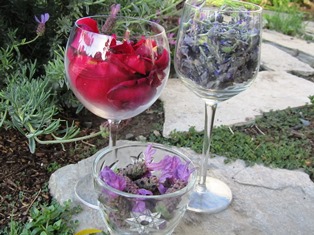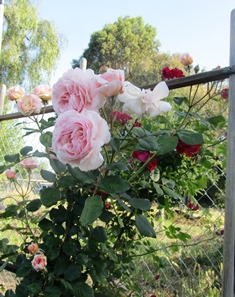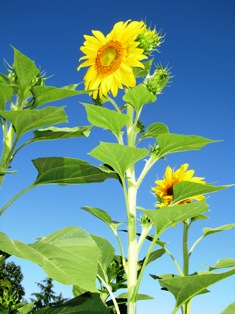Fruit Spreads Make Life a Little Sweeter
On the Henny Penny Farmette, we care for a small orchard of fruit trees. Each spring, summer, and fall, we harvest fruits to make sweet spreads. Whether spooned onto warm bread or waffles, scooped onto ice cream, or sandwiched between cookies, our homemade spreads offer a tasty reminder of the seasons of warmth.

There are lots of different types of spreads, including chutneys, compotes, conserves, fruit butters, jams, jellies, and preserves. Each type has special characteristics. The following lists outline some of the differences between these delicious spreads.

The Three C’s–Chutneys, Compotes, and Conserves
Chutneys are condiments that offer a variety of textures, from smooth to chunky, due to the type of fruit used as well as the blend of sugar, spices, and vinegar. The addition of chili peppers adds heat.
Compotes are often composed of fruit, either whole or in pieces, in a sugar-water syrup that includes spices.
Conserves are flavor- and texture-enhanced by adding to the jam such ingredients as dried fruit and nuts.

Preserves are spreads that include chunks of fruit cooked into the jam mixture. A marmalade is a type of preserve. We like marmalade made from citrus such as naval and blood oranges, lemons, and kumquats. You can make a lovely berry preserve by combining different types of berries with a sparkling juice, lemon zest, and sugar. Or, try cranberries and oranges for a tasty preserve for morning toast.
Fruit butters are spreads that have been cooked until all fruit has been incorporated in a buttery consistency. These blends of fruit and spice make them particularly sweet.
Jellies are made mainly from the juice of fruit cooked with sugar and pectin (to thicken). We make jelly from our late summer pomegranates, but your options are expansive when you consider all the types of fruits, flowers (yes flowers, like violet and lavender make wonderful jellies), and fruit juices that can be combined into a delicious jelly.
If you enjoy reading about gardening, preserving produce and fruits, and other country living topics, check out my Henny Penny Farmette series of cozy mysteries. The novels and my self-help, wellness, and spirituality books are available online and everywhere books are sold. See, https://www.amazon.com/Meera-Lester/e/B001JP835E%3Fref=dbs_a_mng_rwt_scns_share
Crafts You Can Make from Your Backyard Garden
Invariably, when fall and winter holidays roll around each year, I find myself wishing that I’d planned ahead and utilized more raw materials from the garden for gift-giving. If you have had a similar experience, here are some ideas for turning what you grow into heart-warming gifts.
At summer’s end, harvest the seeds of your favorite flowers like cosmos, sunflowers, nasturtiums, zinnias, and even vegetables. Dry and re-package into paper envelopes that you hand-stamp, emboss, or otherwise embellish for gift-giving. Be sure to include information about how to grow the plant.

Rose petals, Spanish lavender, and French perfume lavender can be used to make a flower essences or potpourri
Flowers and herbs, picked at their zenith, can be turned into potpourri, fragrant soaps, soothing lotions, and skin moisturizers.
If you keep bees in your backyard garden, consider using the extra wax for dipping candles. Of course, honey is highly prized for its healthful properties, so be sure to jar up plenty of honey for gift-giving occasions.
Vines, berries, and pine cones are easily transformed into wreaths and dry arrangements.
A bottle of vodka, gin, or other spirits can be transformed into a gourmet gift by the addition of sun-ripened berries, herbs, vegetables (such a cucumber), or fruits and then stored in a dark, cool place for at least six weeks.
Gourds make lovely bird feeders and bird houses.
Just imagine the delight a dried-pepper wreath, a garlic braid, or jars of dried beans and seeds might evoke.
Make sheets of homemade paper, incorporating colorful rose petals, lavender, or pansies. Making paper is easy if you have a blender, some scraps of paper (junk mail works), and water.
Seed cakes, created from crunchy peanut butter, seeds, nuts, and dried fruit, make great gifts for bird lovers who can place them near feeders during the cold months when the bird must vigorously forage for food.

Re-potted cuttings of your garden favorites make lovely gifts for other gardeners in your family or circle of friends
Take cuttings in fall or early spring from your roses, dip the cuttings into root hormone, and plant the cuttings into a pot of soil that you keep damp until the roots have formed. Or dig bulbs (bearded irises, for example) and place in a tin for gift-giving.
Preserve jars of pie-filling, do up crocks of pickles, or create mouth-watering chutneys and special relishes. Wrap the jar lids in gingham and ribbon. Use hot-water canning of fruit and citrus into jam, jelly, and marmalade. Place jars of these items into a food basket, made festive with the addition of colorful tea towels or tissue paper and ribbon.
Use clean, dry corn husks for tamale-making, or craft them into corn husk dolls.
With a little forethought and advance planning, you’ll have plenty of backyard bounty to harvest and turn into gifts for almost any holiday or special occasion.
 Facebook
Facebook Goodreads
Goodreads LinkedIn
LinkedIn Meera Lester
Meera Lester Twitter
Twitter






